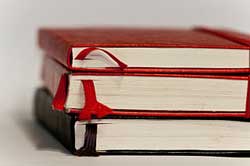 Two weeks ago, in the column called “Armchair Adventures,” I happened to mention that Heywood Hale Broun used to scrawl his book reviews on lined yellow paper. What I didn’t say, though, was that I recognized that paper. I’d used similar Goldenrod sheets throughout elementary school.
Two weeks ago, in the column called “Armchair Adventures,” I happened to mention that Heywood Hale Broun used to scrawl his book reviews on lined yellow paper. What I didn’t say, though, was that I recognized that paper. I’d used similar Goldenrod sheets throughout elementary school.
Every September, kids would stop by W. T. Grant’s or Woolworth’s to buy either Goldenrod or Big Chief school tablets. Today I can’t recall if Goldenrod was a brand name or just a color designation, but I do remember a cover artfully decorated with stems of flowers. To the nine-year-old connoisseur, faded yellow paper seemed distinctly classier than Big Chief’s dull off-white stock, which was speckled with bits of pulp and little better than newsprint. But whichever style you chose, you did need to hand-punch holes in the side of the pages when adding homework to your three-ring binder. Tough guys would show off by seeing how many sheets they could perforate at once.
Over the years since, I’ve been slightly obsessed with paper and notebooks. Among my most precious possessions is a small light-blue, breviary-sized volume—four-and-a-half inches wide, seven inches tall—made by a company called Denbigh. There are 140 faintly ruled pages, and about half of them are still blank. This is my commonplace book, into which I copy favorite passages and quotations from my reading. The first entry was made when I was in my early 20s: “How fortunate beyond all others is the man who, in order to adjust himself to fate, is not required to cast away his whole preceding life!” That comes from Goethe, and shows the rather lugubrious worldview of a young Werther.
The most recent addition is an observation taken from the introduction to the Second Fontana Book of Great Ghost Stories. Robert Aickman, a master of the genre, is talking about Edith Wharton’s most famous supernatural tale: “The important ingredient in ‘Afterward’ is not the past offense but the truth, reaching far beyond ethics, that we can none of us identify what is crucial until it is too late.” I see that my worldview hasn’t grown any cheerier since my college days.
Near my desk I keep a large plastic carton filled with fresh notebooks and stationery of various kinds, sizes, and qualities. At one point I owned a few of those ubiquitous Moleskines—the kind supposedly used by travel writer Bruce Chatwin—but they tend to be so expensive that I found myself hesitating to mar their virgin whiteness with my doodles, to-do-lists, and earth-shaking, indeed paradigm-altering, observations about this and that. Instead I much prefer school composition books, generally those with austere, speckled black-and-white covers, though in moments of giddy abandon I’ve sometimes splurged on the versions bound in masculine dark blue or eye-catching neon green. In the fall one can generally pick up such school notebooks at sale prices, often three for two dollars. I usually look for quadrille ruled—the kind with little squares—but these are often hard to find.
Quadrille paper always reminds me of France, where I bought similar notebooks from the Librairie Gibert. In them I used to record my various misadventures, set down overheard French expressions and idioms, or add to the list of books recommended to me by the global wanderers I’d meet in youth hostels. In those golden days, I often wore a navy-blue sailor’s sweater that buttoned rakishly at the shoulder. Sometimes I’d even sport a dark brown cap called a casquette. When sipping pastis and scribbling with my Bic pen, I was sure that I looked every inch an existentialist.
Poking through my box of unused notebooks, many of them scavenged at thrift stores, I see a large red-covered Standard Diary from 2005, a light green-backed record book from the Federal Supply Service, a large journal of 384 “acid-free” pages, a small black notebook with a ribbon band to keep the covers closed, a dozen student examination “blue books” from the University of Central Florida and the University of Maryland, a couple of very small Oxford Memo notebooks (a gift from the writer Paul Di Filippo), four or five scratch pads from various Marriott and Hilton hotels, and a half a dozen reporter’s notebooks. These last I pick up at The Washington Post whenever I go in to see my editors.
The only kind of notebook I actively dislike is the Steno Pad, entirely because of that vertical line down the middle of the page. I presume it has some arcane secretarial use, but to me it’s both ugly and confusing.
Over the past couple of years I’ve occasionally tried to use my computer’s stickies and online calendar for notes to myself, but to no avail. My Great Thoughts arrive all too often while I’m reading or out taking a walk or trying to fall asleep. So I like to be able to reach for a notebook, wherever I am. Almost every time I flip one open, especially if it’s horizontally ruled, I find myself automatically murmuring one of my favorite mantras: “If they give you lined paper, write crosswise.”

